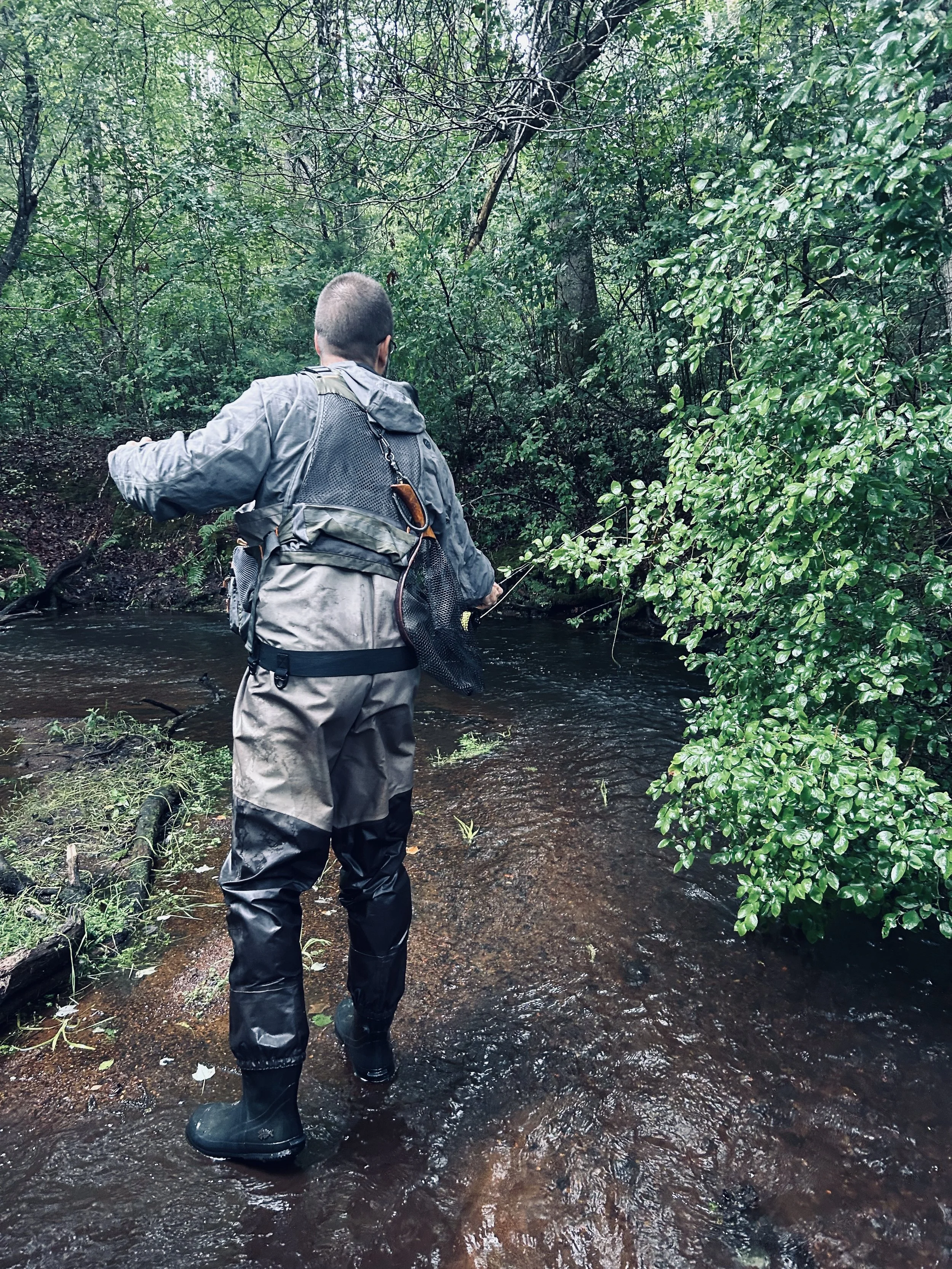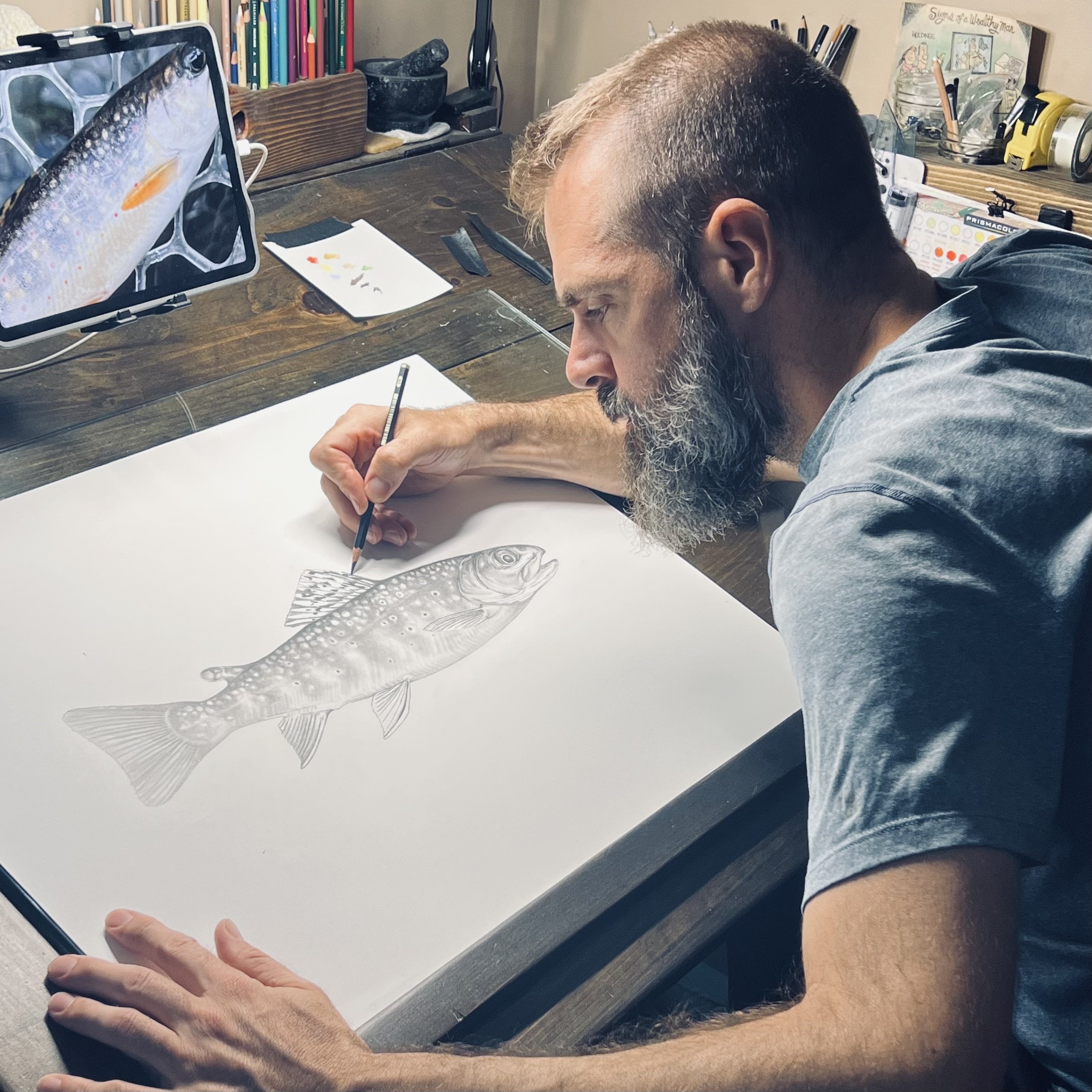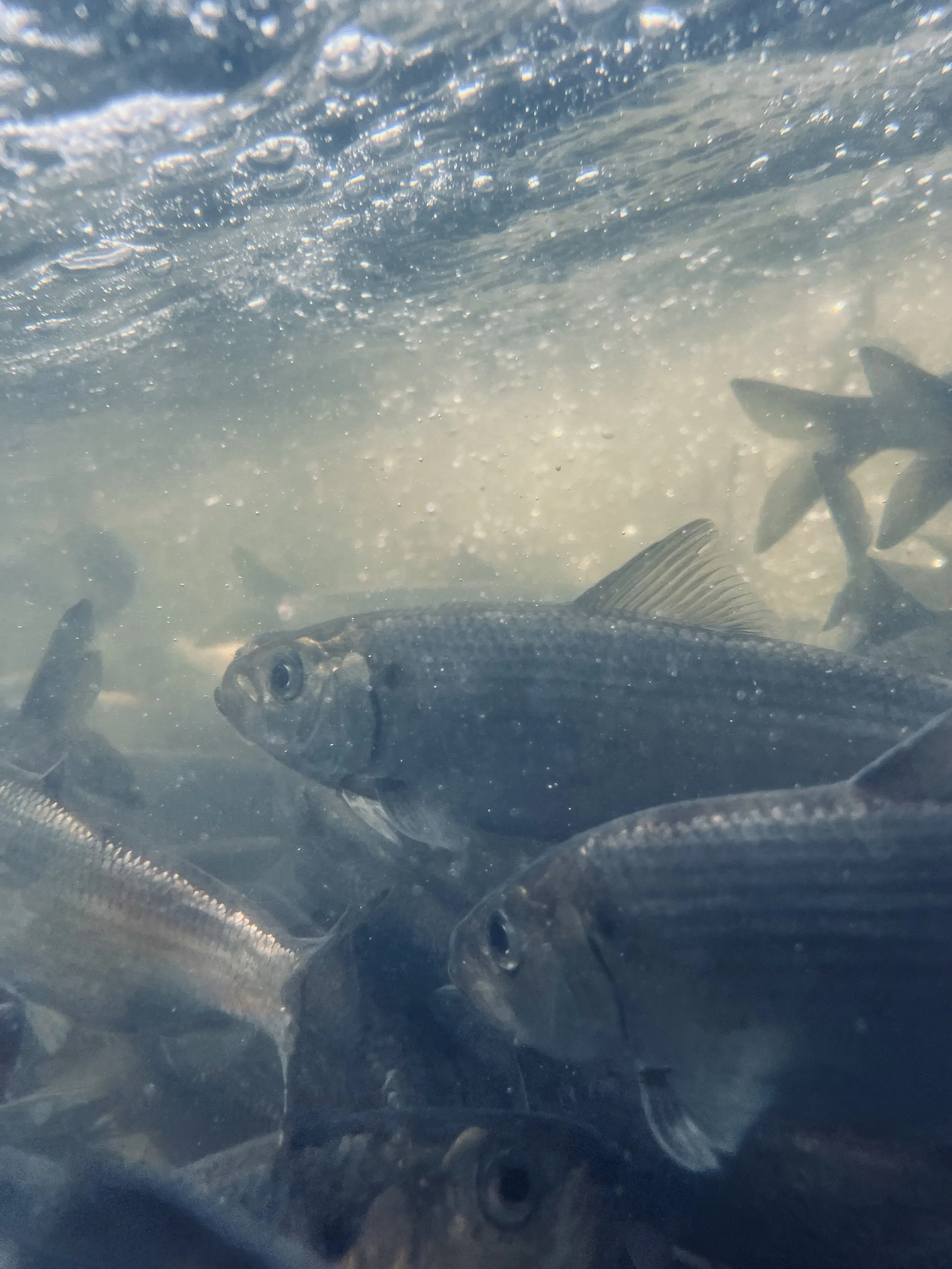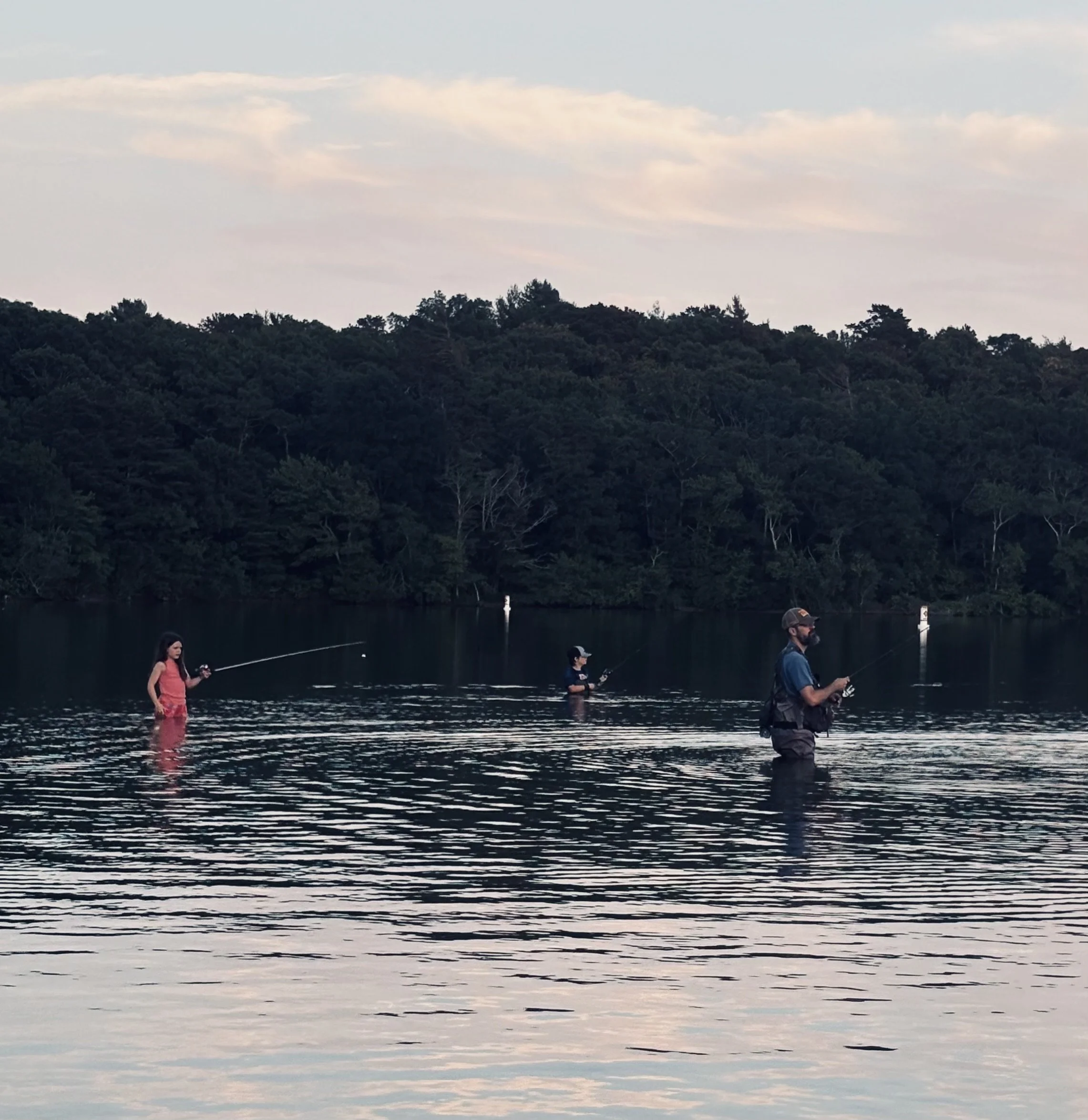Confluence: Where Water, Stories, and a Life's Work Meet
Fishing the Mashpee River on Cape Cod.
The river bends sharply around a stand of beech trees, and I step into the water, letting the current tug at my waders. Sunlight glints off the water, casting flickering shadows across the cobble bed below. I hold the fishing pole loosely in one hand, scanning for the quick flash of a trout darting through the current. Around me, schools of juvenile herring glide downstream, embarking on the opening chapter of their life’s journey.
This is the Mashpee River on Cape Cod. For me, standing in it now is a homecoming of sorts—knee-deep in the same kind of waters that shaped my earliest memories, tracing the same bends I once imagined as a child growing up in northern Massachusetts. The confluence of my life's currents—curiosity, science, art, and restoration—has brought me back here.
Headwaters of Curiosity
Long before I could navigate nautical charts or read scientific reports, I was learning to follow water with nothing more than a bucket and boundless curiosity. Behind my childhood home, swamps and small brooks twisted through the woods, carrying life in the quiet flow of water. I would spend endless afternoons wandering the brooks and ponds, peering into dark surfaces to spot frogs or minnows, captivated by the hidden rhythms of these waters.
Fishing trips with my dad added structure and ritual to that early exploration. We would rise in the morning, pack our gear, and head to the local rivers and ponds where the air smelled of pine and rain-soaked earth. He taught me patience, precision, and respect—the silent lessons that come from waiting for a fish to take the bait, from observing without disturbing. In those moments, the natural world wasn't just a backdrop; it was a teacher.
Those early experiences formed the first confluence in my life: the meeting of curiosity, observation, and wonder. I didn't know it then, but they set the current that would carry me across oceans and back into the streams of my youth.
At sea in the Gulf of Maine holding an Atlantic cod.
Into the Sea: Science as Compass
My curiosity led me from freshwater streams to saltwater horizons. After college, I worked for the National Oceanic and Atmospheric Administration (NOAA) as a fisheries scientist, diving into research that spanned New England's coasts. I spent time at sea on research vessels, measuring populations, analyzing trends, and managing species critical to both ecosystems and local communities. The work demanded rigor, precision, and an ability to see connections on a scale I had never imagined.
Yet even amid these vast oceanic landscapes, I often found my mind drifting back to the intimacy of a small river bend, the tactile satisfaction of lifting a stone to see what life clung beneath it. Saltwater science gave me perspective and skills; freshwater had given me roots and wonder.
During this time, I realized that facts alone—no matter how meticulously gathered—don’t tell the whole story. Science shows us the "what," but not always the "why it matters." To reach people, to inspire care for these systems, I needed other languages.
In the studio working on a Brook Trout drawing.
The Confluence of Art and Science
Those alternative forms of communication came through the Waquoit Bay Fish Company, an art-science studio I founded to bridge the worlds I loved. What began as an experiment in creative expression quickly became a full exploration of how art and science intersect.
Through this work, I discovered that data could be translated into visuals that make ecological patterns tangible, that storytelling could transform numbers into meaning. Scientific illustration, photography, and prose became channels to communicate not just findings, but the deeper human connections to place.
In collaboration with partners, I developed projects that combined ecological data with lived experience, created art exhibits that captivated and informed, and designed educational materials that honored both the precision of measurement and the poetry of close observation. In these works, confluence was both literal and metaphorical: scientific rigor met creative insight, traditional knowledge intertwined with fresh perspectives, and communities deepened their connection to the waters they rely on and cherish.
Art didn't replace science, and science didn't replace art. Together, they formed a current far richer than either could provide alone—much like the meeting of rivers that nurtures broader, more resilient ecosystems.
Taking a measurement on a water-level logger installed on the Mashpee River.
Returning Upstream: Freshwater Restoration
In recent years, my path has bent back toward freshwater. Joining the Association to Preserve Cape Cod (APCC), I began working on stream restoration and river herring monitoring across Cape Cod. Brook trout, once common in these waters, had nearly vanished, their habitat fragmented by dams and development. River herring runs had dwindled, disconnected from the ponds and rivers that once defined their life cycles.
Now, armed with data from decades of monitoring, community volunteers, and tools I've helped develop, I guide these systems back toward health. Each dam removed, each culvert replaced, each restored riffle or pool represents more than a technical achievement—it's a reconnection, a chance to restore the flow of life and knowledge.
Standing in a restored stream, I often recall the hours I spent as a child wandering a meandering brook, the lessons my father taught me about patience and observation, and the years of marine work that honed my analytical perspective. These streams have become my classroom again, my laboratory, and my reminder that confluence happens not only in water but in life—where past and present, curiosity and expertise, science and art converge.
River herring make their way up a Cape Cod stream.
Herring as a Mirror of Home
Nothing embodies confluence more clearly than the spring migration of river herring. Alewife and blueback herring push upstream, navigating obstacles, returning instinctively to the ponds and streams where they were born. They carry nutrients from the sea into freshwater systems, linking ecosystems in ways both visible and subtle.
Watching them, I feel a deep personal resonance. Their journey mirrors my own: a boy exploring hidden brooks, a scientist at sea, an artist finding new ways to communicate ecological stories—and now, returning to freshwater restoration work. Just as the herring come home to the waters that shaped them, I have found my way back to the streams that first sparked my curiosity, bringing with me the skills, knowledge, and perspective gathered along the way.
Standing knee-deep in the river, watching silver flashes dart beneath the surface, I see the full trajectory of my life converge in this moment. The herring remind me that coming home isn't regression—it's the culmination of experience, a meeting of currents that strengthens both the river and the traveler. Their instinctual return carries the wisdom of the ocean, just as my journey brings the breadth of oceanic research, creative exploration, and community engagement back to these local waters.
In this sense, the herring migration transcends natural phenomenon—it becomes a living metaphor for the flow of a life built at the intersections of curiosity, science, art, and restoration. Each fish returning upstream reflects the rhythm of a career and a life coming full circle, guided by both memory and momentum.
Fishing with my children.
Full Circle
The Waquoit Bay Fish Company taught me to honor the meeting of art and science, to see creativity and rigor as partners rather than opposites. APCC restoration work reconnects me with the freshwater that first inspired my curiosity. Now, I share these same waters with my children—teaching them to fish, to notice the subtle currents, the life hiding beneath stones, and the quiet rhythms of a healthy pond or stream. Watching their eyes light up with wonder, I feel the arc of my own journey come full circle: from a boy exploring hidden brooks, to a scientist and artist, to a parent passing on curiosity and care.
At every confluence, there is possibility—every meeting of waters brings turbulence and richness, challenge and opportunity. In the waters of Cape Cod, in the stories we tell, in the art we create, and in the data we gather, the confluence continues—shaping ecosystems, communities, and lives. And in that still, ever-changing water, I find the heart of my work: to follow the currents, to nurture connection, and to celebrate the living intersections where science, art, and the human spirit meet.






